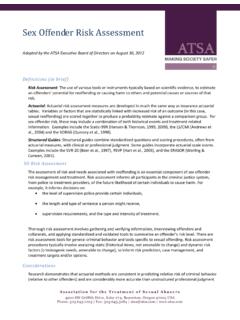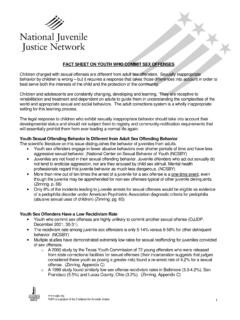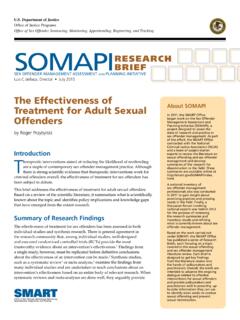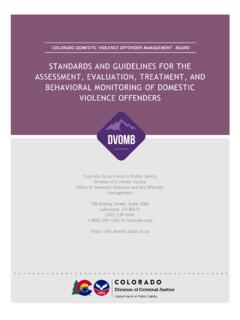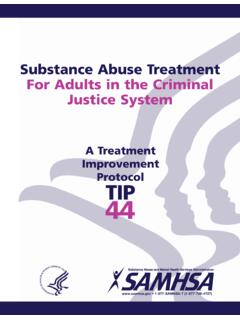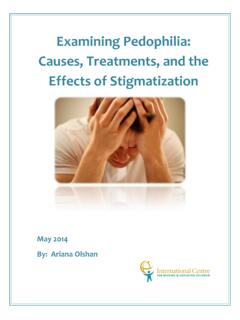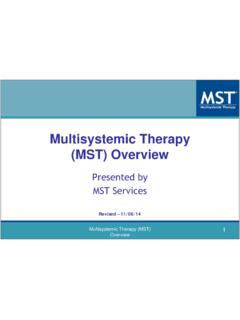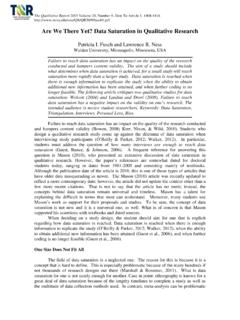Transcription of Treatment of Sexual Offenders: Research, Best Practices ...
1 INTERNATIONAL JOURNAL OF BEHAVIORAL CONSULTATION AND THERAPY 2013, ALL RIGHTS RESERVED. 2013, VOL. 8, NO. 3-4 ISSN: 1555 7855. Treatment of Sexual Offenders: research , er, 2006). Thus, the most intensive levels of service should be reserved for higher risk offenders, while best Practices , and Emerging Models lower levels of intervention (or no intervention). should be applied to lower risk offenders. In fact, Pamela M. Yates low risk offenders likely do not require specialized Cabot Consulting and research Services Treatment at all, and will benefit from routine super- vision (Andrews & Bonta, 2010; Hanson & Yates, Abstract 2013).
2 Treatment of Sexual offenders has evolved substantially over the years; various theoretical and practice models Adherence to the risk principle, in addition to being of Treatment been developed, modified, refined, and proposed over time. The predominant current recommended the best use of limited resources, demonstrates that approach, supported by research , adheres to specific principles of effective correctional intervention, follows a Treatment is most effective when its level of intensity cognitive-behavioral, skills-based orientation, and explicitly targets risk factors empirically associated with Sexual is matched to risk (Andrews & Bonta, 2010; Gen- offending and with recidivism, such that risk of re-offending may be reduced.)
3 Cognitive-behavioral Treatment dreau & Goggin, 1996, 1997; Gendreau, Little, &. Goggin, 1996; Gordon & Nicholaichuk, 1996; Han- focuses on changing behavior, cognition, and affect, using a skills-based approach, with the aim of reducing risk son et al., 2009; Nicholaichuk, 1996). That is, when of recidivism, and includes specific characteristics and methods on the part of Treatment providers. Treatment is higher risk offenders receive higher intensity treat- also guided by specific principles of intervention to maximize effectiveness. New models of Treatment have been ment, and moderate risk offenders receive interven- proposed with the aim of replacing and/or augmenting existing models.
4 This article discusses existing and emerg- tion at more moderate levels of intensity, the impact ing models, their research basis, and recommendations for best practice in the Treatment of Sexual offenders. on reduced recidivism is greatest. Furthermore, research indicates that, when risk and Treatment Keywords intensity are not appropriately matched, recidivism Sexual offender Treatment ; adult Sexual offenders; good lives model; risk, need, and responsivity, self-regulation can increase as a function of Treatment , as in the case of lower risk offenders who receive Treatment at an intensity that is greater than required to address Sexual offending has long been recognized as a se- al nature of Sexual offending became evident, and their needs (Andrews & Bonta, 2010.)
5 Lowenkamp, rious problem with significant impacts on victims, Treatment approaches incorporated multiple ele- & Latessa, 2002; Lowenkamp, et al., 2006). their families, and society at large. Coinciding with ments in order to address these multiple influences Among Sexual offenders, specific static and dynam- this recognition has been the development and im- on behavior and Sexual offending risk (Marshall et ic risk factors have been associated with increased plementation of Treatment interventions designed al., 1999; Marshall, Marshall, Serran, & Fernandez, risk of recidivism. Static risk factors those that to reduce the risk of recidivism, empirical research 2006; Yates, et al.
6 , 2000). cannot be changed through intervention include into Treatment effectiveness, and an increase in the Many early interventions, such as psychotherapy younger age, previous Sexual offenses, the commis- availability of Treatment programs for Sexual of- and neurosurgery, have been found to be ineffective sion of non-contact Sexual offenses and non- Sexual fenders (McGrath et al., 2010). Current best prac- (see Yates, 2002, 2003, for a review), while others, violent offenses, and offending against male victims, tice involves the application of cognitive-behavioral including pharmacological interventions, are po- unrelated victims, and strangers (Hanson & Thorn- interventions that target risk and that adhere to tentially promising in some specific cases (Brad- ton, 1999).
7 Dynamic risk factors are discussed be- the principles of effective correctional interven- ford, 1990; Grossman, Martis, & Fichtner, 1999; low. tion (Andrews & Bonta, 2010; Hanson, Bourgon, Meyer, Cole, & Emory, 1992). Still others, including When considering Treatment intensity, little re- Helmus, & Hodgson, 2009). In addition, meta-an- relapse prevention, continue to be used in spite of search has been conducted regarding the most alytic research has found that cognitive-behavioral an absence of research support for their effective- appropriate length of intervention, and practice Treatment is most effective in reducing recidivism ness.
8 Treatment models that have been shown to be varies substantially across jurisdictions (McGrath, in comparison to both other types of Treatment effective, and emerging promising models, are the et al., 2010). Some programs recommend between and to criminal sanctions (Hanson et al., 2002; L - focus of this review. 80 (Beech & Mann, 2002) and 120 contact hours sel & Schmucker, 2005). Lastly, research indicates ( , Marshall, et al., 2006), while others recom- that effective therapists and therapeutic techniques Principles of Effective mend between 160 to 195 contact hours for mod- are associated with improved outcomes (Beech & Correctional Intervention erate risk Sexual offenders and approximately 300.)
9 Fordham, 1997; Marshall, Anderson, & Fernandez, hours of Treatment contact for high risk offenders 1999; Marshall et al., 2002, 2003; Serran, Fernandez, In general, in correctional intervention with offend- ers, specific principles have been found to be essen- (Correctional Service Canada, 2000). In a com- Marshall, & Mann, 2003; Shingler & Mann, 2006; prehensive evaluation, Bourgon and Armstrong Yates et al., 2000). In this article, a review of Sexual tial in interventions designed to reduce recidivism, and specifically, the principles of risk, need, and re- (2005) examined Treatment intensity as a function offender Treatment is provided, with accompanying of both risk and criminogenic needs (see below).
10 research support for specific approaches. This is sponsivity (RNR model; Andrews & Bonta, 2010). While originally intended to be applied predomi- They found that 100 contact hours was sufficient to followed by a review of emerging Treatment models reduce recidivism for general offenders presenting and their potential to inform the practice of Sexual nantly to criminal justice sanctions ( , sentencing, diversion, and supervision), in practice this model with moderate risk and few criminogenic needs, offender Treatment . 200 hours was more effective when offenders were has additionally been applied to Treatment , and per- Various models of sex offender Treatment have been either high risk or had multiple criminogenic needs, haps more so to Treatment than to sanctions.










